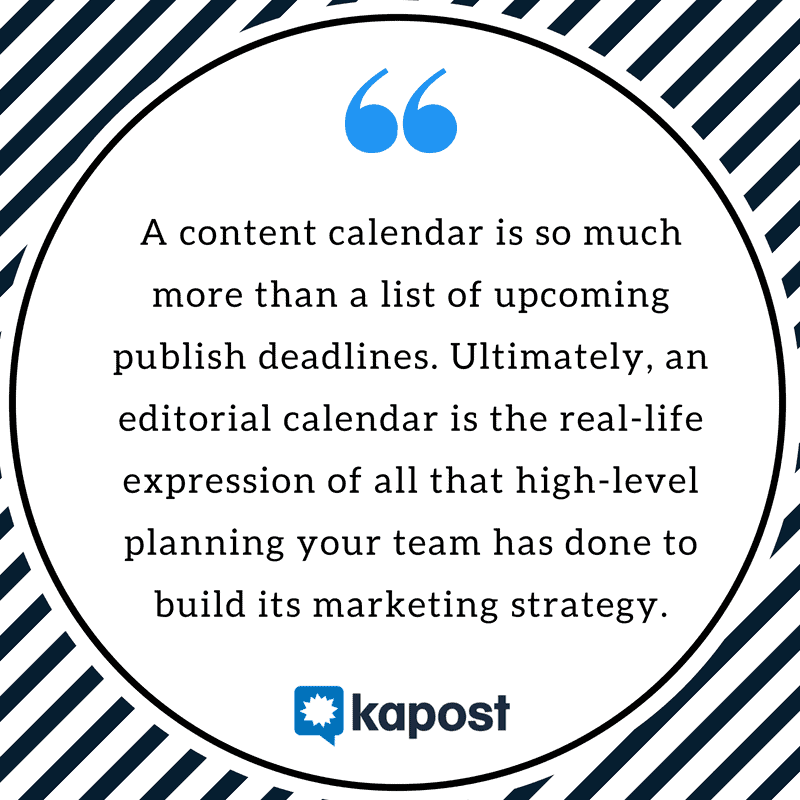Like so many strategies and tools employed by today’s B2B marketers, the content calendar is nothing new. In fact, it’s something many of us likely associate with traditional print publishers, like magazines or newspapers. But a content calendar is must-have for B2B marketers, too, and there’s a world of difference between the world class and the just okay.
At Kapost, our content calendar is the quickest way for anyone in the company to get a snapshot of our what’s coming down the pipeline. That’s why ensuring it’s accessible, accurate, and up to date—not to mention, a tactical expression of our larger thematic planning—is a key priority for our content team.
We think it’s high time we showed some love for this often misunderstood piece of a top-notch content operation. Let’s dissect what a content calendar is, what it isn’t, and what having a good one can do for your business.
What Exactly is a Content Calendar and Why Do You Need One?

A content calendar is so much more than a list of upcoming publish deadlines. Ultimately, an editorial calendar is the real-life expression of all that high-level planning your team has done to build its marketing strategy.
If strategic planning is the foundation of marketing and content is our product, the content calendar is the tactical apparatus that makes your plans happen. It’s not a strategy in and of itself, but your big strategic plans can’t come to life without it. There are five key components of a top-notch content calendar.
1. It’s a Living Document
We all know what they say about “even the best-laid plans.” No matter how meticulously you build out your publishing schedule, things will inevitably change. That’s why your content calendar needs to be a living, breathing document—not an idealistic dream from three months ago. If people can’t trust that your content calendar is accurate, it becomes more or less useless, which brings me to component number two…
2. It’s Visible and Accessible
It’s a no-brainer that everyone on the content team should have access to the calendar, but they’re not the only ones who benefit from visibility. We at Kapost go so far as to insist that a diverse group of stakeholders know about our plans by holding weekly content review meetings dedicated to going over every piece of content scheduled to publish for the next two weeks—from emails to eBooks—to ensure everyone is on the same page.
In addition to the content team, we invite:
- Product marketing
- Marketing ops
- Web and graphic designers
- SDRs and AEs
We believe it’s important that every stakeholder understands our plans, has an opportunity to voice concerns and ask questions and can proactively address potential bottlenecks—all so that we are confident our content is on track and leveraged accordingly.
3. It’s Comprehensive
Sometimes we think of a content calendar as nothing more than a list of upcoming blog posts, but that’s only one piece of the puzzle. Your content calendar should include everything you’re pushing out to the public, from product collateral to virtual events. Seeing everything in one place allows your team to spot areas of over- or under-coverage and make sure that the content experience you’re creating is truly customer-centric.
Done right, your calendar should reflect central themes and thoughtful cadences, allowing consumers to digest your content in a way that feels intentional and cohesive. Seeing everything in one place allows you to avoid mistakes like sending three different asset launch emails and invites to the same section of your database in the same week, risking alienating an important part of your audience.
That said, the best content calendars are filterable, allowing you to zoom in on certain types of content whenever you need to take a closer look.
4. It’s Backed by Established Workflows
A plan is all well and good, but it’s destined to fall apart if it isn’t feasible. That’s where workflows come in. We could write an entire blog post on workflows. (In fact, we have), but the key here is that pre-set workflows allow you to confidently set deadlines because you already know how long each asset takes to produce.
5. It’s Strategic
But wait, careful readers are no-doubt asking, didn’t you say a content calendar isn’t the same as a strategic plan? Yes! But that doesn’t mean there isn’t strategy involved.
The content calendar takes strategy to a more granular level, allowing you to organize the big themes and assets you’ve already planned into customer-centric experiences.
For example, let’s say your team is planning to launch an eBook about topic X sometime in Q4, as well as to create derivative assets to support it (a webinar, several blog posts, an infographic, etc.). When building out your content calendar, you’ll need to consider the optimal time to release the big asset as well as consider the best time to publish your derivative content (both before and after the big launch). You’ll want to ensure your audience gets just the right amount of topic X—neither overwhelmed nor underserved—and that these assets fit within your ongoing cadence of publishing (like your newsletter).
Key Benefits of a Well-Managed Content Calendar
We’ve covered what it looks like, but what’s the ROI?
1. It Makes Your Strategy Real
What’s the point of a big, fancy strategic plan if it never gets put into action? A content calendar is your chance to translate high-level ideas into solid plans of action.
2. It Builds Alignment
Our recent marketing and sales alignment benchmark report found that just 32% of marketers (and just 43% of salespeople) believe sales uses marketing content to its full potential. A big reason for that is findability of content, but that’s a topic for another day.

By providing visibility into what content is on the way, sales is prepared to leverage new assets. (Plus, they’ll stop asking, “When is that going live, again?”)
3. It Creates Better Customer Experience
A well-managed calendar is often adjusted. Just a few weeks ago we realized that all of our blogs scheduled for the week were centered on a single topic, so we took steps to move things around. Proactively realizing these potential sticking points and adapting as necessary keeps the customer top-of-mind and makes a big difference for the end user.
4. It Protects Creators From Ad Hoc Requests
Last-minute, unplanned asks are the bane of many a marketer’s existence. With a well-planned editorial calendar, you can provide a comprehensive picture of your upcoming plans and show them immediately why their request can’t be squeezed in. It also reminds these requesters of your established processes and encourages them to consult the calendar before running to you.
Want to See How We Do It?
We get a lot of questions about how we at Kapost manage our own editorial calendar, which is why we’re hosting a live webinar to discuss that very topic! On Tuesday, August 28 at 9 a.m. PT/12 p.m. ET. I’ll be joined by colleague Aubrey Harper, Managing Editor of the Kapost Marketeer blog, strategist, and eBook author extraordinaire. Together, we’ll take you behind the scenes of Kapost’s approach, giving you an inside look at our software and our strategy.
I hope you can join us!

